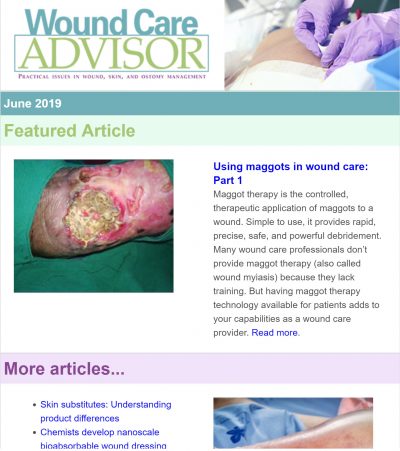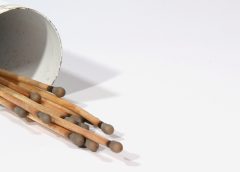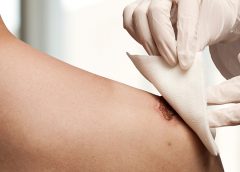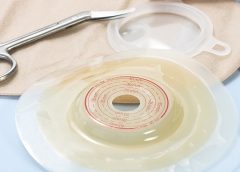Wound Care Advisor is owned and published by HealthCom Media. Wound Care Advisor is peer reviewed. The views and opinions expressed in the editorial and advertising material on this website are those of the authors and advertisers and do not necessarily reflect the opinions or recommendations of the NAWCO, the Editorial Advisory Board members, or the Publisher, Editors and staff of Wound Care Advisor.
Wound Care Advisor attempts to select authorities who are knowledgeable in their fields. However, it does not warrant the expertise of any author, nor is it responsible for any statements made by any author. Certain statements about the uses, dosages, efficacy and characteristics of some drugs mentioned here reflect the opinions or investigational experience of the authors. Nurses should not use any procedures, medications, or other courses of diagnosis or treatment discussed or suggested by authors without evaluating the patient’s conditions and possible contraindications or dangers in use, reviewing any applicable manufacturer’s prescribing or usage information, and comparing these with recommendations of other authorities.
We encourage people with wounds and ostomy questions to contact their care provider; we are unable to provide medical advice.
Read More
How to submit your article
Submit your manuscript electronically as an MS Word file. Follow these guidelines:
- At the top of the first page of the document, place the article title, your initials (not your name), and the date.
- DO NOT include extra hard returns between lines or paragraphs, extra spaces between words, or any special coding.
- Send a separate cover letter that includes your name; credentials; position; address; home, cell, and work telephone numbers; email address; and your employer’s name, city, and state.
- Email the article and any other attachments to [email protected] and [email protected].
What happens to your manuscript after submittal?
- You will receive an email confirming receipt.
- If your manuscript contains clinical information and we believe it has publication potential, we will send it out for blind peer review (neither you nor the reviewers will know who wrote the article). All manuscripts also receive an internal editorial review. After the review, we’ll let you know whether the manuscript has been accepted, accepted pending revisions, or declined.
- If we accept your manuscript for publication, we’ll ask you to sign an agreement that gives HealthCom Media (publisher of Wound Care Advisor) the rights to your article so that it can be published. Each author must sign a separate agreement.
- Your article will go through our in-house editorial process, where professional editors ensure consistency with our editorial style. You will have a chance to review the edited version before it’s published.
- We will email you if we decide not to publish your manuscript.
Thank you for considering publishing in Wound Care Advisor, the official journal of the National Alliance of Wound Care and Ostomy, the official. If you have any questions, please email: Cynthia Saver, RN, MS, at [email protected] or [email protected].
Read More
Turning programs are essential to prevent and promote healing of pressure ulcers and to prevent the many negative effects of immobility, ranging from constipation to respiratory infections. However, turning a patient often puts a caregiver’s body in an awkward position, which can lead to musculoskeletal damage, especially back injuries.
According to the U.S. Bureau of Labor Statistics, healthcare workers suffer the highest rate of musculoskeletal disorders for all occupational groups and more than seven times the average rate for all occupations. Direct caregivers are the group most likely to experience musculoskeletal injuries. During turning tasks, excessive forces are imposed on the caregiver’s musculoskeletal structure due to the external load of the patient and the caregiver’s form and position during the task. Fragala and Fragala found that turning patients in bed is one of the highest-risk activities that lead to low back pain. (more…)
Read More
Nearly all clinicians know exercise is good for our physical and mental health. But incorporating it into our busy lives can be a challenge. The only types of exercise some clinicians have time for are working long shifts, juggling life’s demands, balancing the books, jumping on the bandwagon, climbing the ladder of success, and skipping meals.
Clinicians are in a unique position to help patients change their behavior to improve their health. Ironically, the first behavior clinicians need to change is to work toward improving our own exercise habits. (more…)
Read More
Optimizing nutritional status is a key strategy both in preventing and managing pressure ulcers. In patients across all care settings, compromised nutrition— as from poor intake, undesired weight loss, and malnutrition—increases the risk of pressure ulcers. It contributes to altered immune function, impaired collagen synthesis, and decreased tensile strength. In many cases, malnutrition also contributes to wound chronicity and increases the risk for delayed and impaired wound healing. In patients with chronic wounds, such as pressure ulcers, a chronic inflammatory state can induce catabolic metabolism, malnutrition, and dehydration. (more…)
Read More
Support surfaces are consistently recommended for the prevention and treatment of pressure ulcers. So patients can derive optimal benefits from support surfaces, clinicians must understand how to use them effectively. This article answers several questions about these useful tools. (more…)
Read More
Topical application of silver nitrate is often used in wound care to help remove and debride hypergranulation tissue or calloused rolled edges in wounds or ulcerations. It’s also an effective agent to cauterize bleeding in wounds. Silver nitrate is a highly caustic material, so it must be used with caution to prevent damage to healthy tissues. (more…)
Read More
Imagine watching your skin tear, bleed, and turn purple. Imagine, too, the pain and disfigurement you’d feel.
What if you had to live through this experience repeatedly? That’s what many elderly people go through, suffering with skin tears through no fault of their own. Some go on to develop complications.
A skin tear is a traumatic wound caused by shear, friction, or blunt-force trauma that results in a partial- or full-thickness injury. Skin tears are painful because the precipitating injury commonly involves the dermis, which is rich with nerve endings. (more…)
Read More
Using a checklist form to document wound care can make the task easier and faster—and help ensure that you’ve captured all pertinent data needed for assessment, reimbursement, and legal support. But the form itself may not be comprehensive; some important fields may be missing.
Recently, we at Wound Care Advisor received a question from a clinician who was having trouble deciding how to code a patient’s wound in her hospital’s electronic health record (EHR). Her patient’s specific wound and tissue types weren’t available options in the dropdown menu on the software system. Luckily, on investigating, we discovered her system provided the option to override the checklist and add comments in a notes section. (more…)
Read More
Self-management ostomy program improves HRQOL
A five-session ostomy self-care program with a curriculum based on the Chronic Care Model can improve health-related quality of life (HRQOL), according to a study in Psycho-Oncology.
“A chronic care ostomy self-management program for cancer survivors” describes results from a longitudinal pilot study of 38 people. Participants reported sustained improvements in patient activation, self-efficacy, total HRQOL, and physical and social well-being. Most patients had a history of rectal cancer (60.5%) or bladder cancer (28.9%). (more…)
Read More









